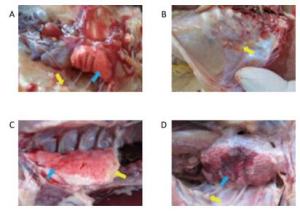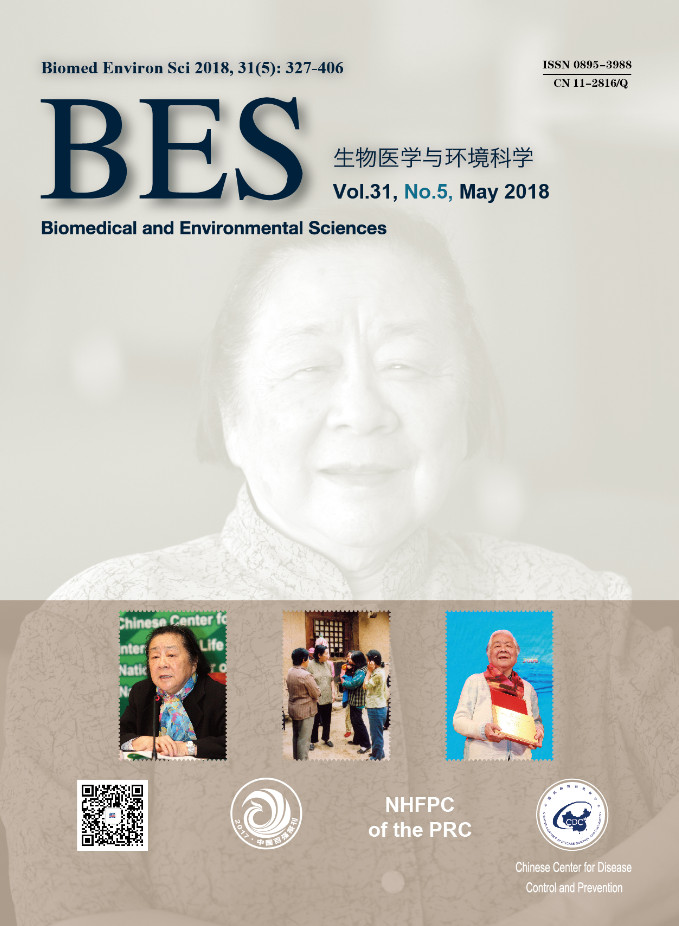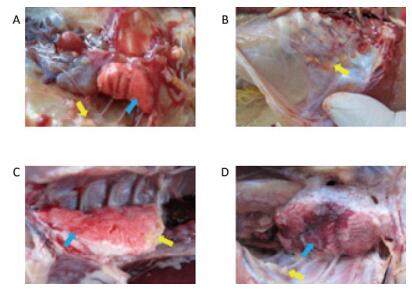-
Airsacculitis is the inflammation of the mucous membrane of birds' air sacs. It has been prevalent in most areas in the Chinese poultry since 2012. Chickens of all ages could be infected, even newborn chicks. Numerous microorganisms are responsible for air sac disease and more than one infectious agent is often identified in an outbreak. In general, it is reported that bacteria such as Escherichia coli (E.coli), Mycoplasma gallisepticum (MG) or viruses such as Infectious bronchitis virus (IBV), Newcastle disease virus (NDV) and Avian influenza virus are most relevant. A series of treatments which targeted at the pathogens mentioned above have been applied, but without significant success, which implies another sources of infection. AMPV infection might contribute to avian airsacculitis[1] and it might co-infect with other pathogens. In a recent survey, both AMPV subtype B and C were identified and seropositivity ranged from 52.4% to 74.1% in Chinese poultry farms[2]. In China ORT was identified in diseased birds from Guangxi, Shandong, Henan, Hubei and Jiangsu from 2004 to 2016[3]. ORT infection usually aggravated respiratory difficulty induced by AMPV and CPS inoculation[4]. Guo et al. using a RT-PCR assay[5] indicated that 24.7% (442/1, 791) of chickens were infected with CPS, and Specific pathogen free (SPF) chickens inoculated with CPS and then AIV H9N2 had severe respiratory difficulty and exhibited 35% mortality[6]. The understanding of the association between avian airsaculitis and these three agents will shed light on the etiology of airsacculitis in poultry.
During the period December 2014 to May 2015, we surveyed 14 poultry farms with outbreaks of seasonal airsacculits in seven provinces of China (Table S1, available in www.besjournal.com). A total of 673 blood samples of breeders with a typical respiratory conditions were collected (248 broilers and 425 layers). For the unmatched case-control study, 210 commercial broilers and 220 commercial layers, which added up to 430 birds, were selected (from a farm we investigated in Hebei) (Table S2, available in www.besjournal.com). Blood sera were centrifuged (3500 rpm for 10 min) and stored at-80 ℃ until assayed. Blood samples were tested with commercial ELISA kits (IDEXX, Beijing, China) to exclude the infections of E.coli (99-08701), MG (99-06729), IBV (99-09262), NDV (99-09263), and Avian influenza (99-09262). Detailed numbers of case and control birds were exhibited in Table S2. The experiments were approved by an ethical board at the China Agricultural University in full accordance with ethical principles and all birds were handled following humane protocols that minimized pain in the animals.
Area Time 2014.12 2015.01 2015.02 2015.03 2015.04 2015.05 Liaoning 
■:23○:15 
●:22Beijing □:15
■:16
●:26Tianjing 
■:16○:16 
●:24 Heibei 
●:19□:18 ■:26
○:10 ●:26Shandong ○:12
●:18□:17 
○:16 ●:21Jiangsu ■:18 
■:16
●:27Ningxia ○:15
●:20■:16 
■:24 Note. *Squares stand for the broiler. Different symbol means different age of diseased birds. □: 1-15 day-old; 

Table Supplementary Table S1. Sampling Time and Locations
Age Broilers Age Layers Case No. Control No. Case No. Control No. 1 54 54 1 20 21 45 51 51 40-170 34 36 300 56 53 Total 105 105 Total 110 110 Note. *Following instructions from our laboratory, sample selection was performed by the resident veterinarians. Cases mainly exhibited a typical respiratory symptoms (decreased food intake and reduced lacrimation, cough, conjunctivitis, mouth breathing and dyspnea). Autopsy mainly showed that thoracic and/or abdominal air sacs were cloudy, thick, and exhibited a discharge of a fibrous exudate. No other characteristic symptoms or pathological features were found. Control groups were same numbers and age matched with the case groups as well as from the same flock. Birds in control groups were healthy and without any clinical signs. Table Supplementary Table S2. Composition of Birds in Case-controlled Study
Antibodies against AMPV (99-44300) and ORT (99-43600) were also analyzed with commercial ELISA kits (IDEXX, Beijing, China) while CPS-specific IgG antibodies were detected using a MOMP-based ELISA kit (supplied by Professor Daisy Vanorompay, Department of Molecular Biotechnology, Faculty of Bioscience Engineering, Ghent University).
The AMPV, ORT, and CPS positive rate between control and diseased birds in both broilers and layers was summarized using number and frequency with percentage. Spearman correlation analysis was performed to detect the correlation among these three pathogens. The individual effect of pathogen with disease status was analyzed using Chi-square test. Logistic regression model was constructed to analyze the combined effect of these three pathogens, including the two terms and three terms interactions. If possible, adjusted if there was any other virus infection. Infection status was defined into 7 levels: negative, AMPV only, ORT only, CPS only, AMPV and ORT, AMPV and CPS, ORT and CPS, all positive. The infection status difference between broilers and layers was analyzed using Chi-square test. P < 0.05 was considered as significant statistical findings. SPSS 22.0 software was used for all analyses.
To define the infection patterns, we analyzed the seropositivity status of the three pathogens in each case (Table 1). In broilers, AMPV-CPS coinfection was the primary infection pattern. There were no significant differences among all the co- infection patterns. In layers, AMPV-CPS coinfections were the most frequently encountered, followed by AMPV-ORT-CPS co-infections. There was no significant difference between the two patterns.
Variables Infection Pattern Number (%) Broiler Layer Single infection Negative 2 (0.0) 0 (0.0) AMPV positive only 12 (9.0) 2 (1.8) ORT positive only 7 (4.0) 9 (8.2) CPS positive only 7 (3.0) 3 (2.7) Coinfection AMPV & ORT positive 15 (18.1) 11 (10.0) AMPV & CPS positive 27 (27.6) 36 (32.7) ORT & CPS positive 19 (20.0) 16 (14.6) All positive 16 (12.4) 33 (30.0) Note. *Chi-square test was used to compare different infection patterns in either broiler or layer breeders. Compared with single infection, coinfection had a remarkably higher number in broilers (χ2= 49.561, df = 1, P = 0.001). There were no significant difference among different infection types. In layers, number of coinfection was dominantly higher than single infection (χ2= 122.255, df = 1, P = 0.001). Compared with AMPV-ORT and ORT-CPS infection, AMPV-CPS (χ2= 16.911, df = 1, P = 0.001; χ2 = 10.073, df = 1, P = 0.002) and all-positive infection (χ2= 13.750, df = 1, P = 0.001; χ2 = 7.588, df = 1, P = 0.009) had a remarkably higher number. Table 1. Seroprevalence Status in Broilers and Layers with Airsacculitis
In the case-controlled study, we found that exposure to AMPV, ORT, and CPS were significantly associated with avain airsacculitis. The results of univariate binary logistic models are presented in Table 2. CPS exposure was the most serious issue among the three pathogens, as indicated by the highest odds ratio and 95% confidence interval. In layers, both CPS and AMPV exposure contributed more to airsacculitis than that in broilers. ORT exposure was also a risk factor. However, its role might be less than the other two pathogens. Strong interaction effect among two terms and three term interactions were discovered and the effects could not be eliminated due to the limitation of our number of variables. A logistic model was unable to be conducted. From Table S3 (available in www.besjournal.com), it is apparent that the pairwise correlations among the three pathogens were robustly positive. In broilers, AMPV-CPS and ORT-CPS had a similar correlation index (R2), which imply three types of co-infection: AMPV-CPS, ORT-CPS and AMPV-ORT-CPS. In layers, although AMPV-CPS had the highest R2, AMPV-ORT-CPS co-infection could not be excluded, because AMPV-ORT also had a high R2.
Explanatory Variable Broiler (n, %) Layer (n, %) Airsacculitis Control P Value OR (95% CI) Airsacculitis Control P Value OR (95% CI) AMPV Positive 70 (66.7) 23 (21.9) 0.001 7.130
(3.854-13.192)82 (74.5) 19 (17.3) 0.001 13.377
(6.974-25.660)Negative 35 (33.3) 82 (78.1) 28 (25.5) 91 (82.7) ORT Positive 57 (54.3) 15 (14.3) 0.001 7.125
(3.653-13.896)69 (62.7) 31 (39.2) 0.001 4.289
(2.432-7.564)Negative 48 (45.7) 90 (85.7) 41 (37.3) 79 (71.2) CPS Positive 66 (63.3) 16 (15.3) 0.001 10.154
(5.170-19.940)88 (80.0) 13 (11.8) 0.001 29.846
(14.185-62.799)Negative 39 (36.7) 89 (84.7) 22 (20.0) 97 (88.2) Table 2. Comparison of Airsacculitis Positive and Control Birds of All Ages
Variables Broiler Layer R2 P Value R2 P Value AMPV-ORT 0.758 0.000 0.747 0.000 AMPV-CPS 0.867 0.000 0.834 0.000 ORT-CPS 0.886 0.000 0.624 0.000 Note. *AMPV-ORT, AMPV-CPS and ORT-CPS stand for the pairwise correlation of the positivity of three pathogens. Spearman correlation analysis method was applied. P < 0.01 indicates statistical significance. Table Supplementary Table S3. Pairwise Correlation among AMPV, ORT and CPS
In the breeder survey, the results indicated that birds of all ages with respiratory conditions had been exposed to AMPV, ORT, and CPS (Table 3). The positivity of the above three pathogens observed in both 1-day-old broiler and layer breeders suggested the possibility of vertical transmission (Figure S1 available in www.besjouranl.com). Moreover, the high incidence or each pathogen indicates many incidences of co-infection.
Breed Broiler Layer 1-15 (d) 40-170 (d) 180-450 (d) 1-15 (d) 40-170 (d) 450 (d) No. 50 43 155 68 126 231 AMPV positive, n (%) 42 (84.0) 17 (39.5) 123 (79.4) 46 (67.6) 73 (57.9) 173 (74.9) ORT positive, n (%) 45 (90.0) 22 (51.2) 147 (94.8) 50 (73.5) 101 (80.2) 201 (87.0) CPS positive, n (%) 23 (46.0) 27 (62.7) 124 (80.0) 54 (79.4) 88 (69.8) 210 (90.9) Table 3. Seroprevalence of AMPV, ORT, and CPS in Diseased Breeders of All Ages

Figure Supplementary Figure S1. Respiratory lesions in chicken with airsacculitis. (A) 1 day-old broiler; (B) 10 day-old layer; (C) 35 day-old broiler; (D) 200 day-old layer. Blue arrow: haemorrhage of lung surface. Yellow arrow: fibrosis exudation.
In this survey none of the poultry farms had immunized their birds with AMPV, ORT or CPS vaccines. However, high seropositivity against the above 3 antigens was found in the samples during the seasonal airsaculitis that occurred in northern China. Based on the analysis of the case-controlled study, avian airsacculitis was highly associated with infection by AMPV, ORT and CPS. Spearman correlation analysis indicated high association between AMPV and ORT, AMPV and CPS (Table S3), and ORT and CPS. Moreover, we found that the major infection pattern in broilers with airsacculitis was AMPV-CPS co-infection and the primary infection patterns were AMPV-ORT-CPS co-infection or AMPV-CPS co-in layers. Therefore, we concluded that infection with these three major agents contribute to outbreaks of avian respiratory diseases.
The present study is the first to show biological interactions among AMPV, ORT, CPS, and avian respiratory disease not evaluated in previous studies[7]. The patterns of infection suggested that the co-infection with AMPV and CPS might play a major role in the development of avian airsasculits and its co-infection was a dominant pattern both in commercial broilers and layer flock. More importantly, AMPV, ORT, and CPS positive samples were found both in breeder broilers and breeder layers aged 180-450 day, and AMPV, ORT as well as CPS positive samples were detected in 1-day-old chickens after hatching, suggesting the possibility of vertical transmission.
Compared with major viral diseases, (i.e. AIV, NDV and IBV), AMPV, ORT, and CPS infections have been ignored due to the poor understanding of their pathogenesis and their low individual mortality. The pathogenesis of combinations of the above 3 agents remains unclear to date and delays a strategic control of avian airsaculitis in the poultry industry. In previous studies, AMPV infection during the acute phase of a CPS infection aggravated the severity of respiratory distress in broiler turkeys[8]. During a field survey, CPS was involved in infections with E.coli, resulting in exacerbated clinical disease, and CPS infection always preceded an ORT infection in Belgian broilers and a high incidence of maternal antibodies could be detected in 1-day-old broilers. All the above reports indicate the importance of multiple agent's involvement in the pathogenesis of avian respiratory diseases rather than one pathogen alone.
With respect to co-infection with the above 3 pathogens, a comprehensive strategy has been considered to control avian airsaculitis in the poultry industry. Firstly, a vaccination program should be considered as a priority measure when considering long-term protection. A trivalent inactivated ORT vaccine (serotype A, B and C) and AMPV vaccine (attenuate vaccine +inactivated vaccine) are recommended for use in infected regions, particularly on large-scale farms. Currently, a recombinant MOMP vaccine is commercially available in China and it can be applied to breeder flocks to protect the offspring by maternal antibody. Secondly, although antibiotics are recommended to reduce the clinical signs induced by the above 3 pathogens, antibiotic resistance is easily induced due to large scale abuse and short-term therapy[9]. Moreover, highly sensitive drug protocols used for combating the above 3 agents are based on lab test and time administration schedules. In previous reports, Pencillin G, Ampicilin, Enrofloxacin, Tetracycline and Tiamulin were recommended as routine therapies. However, Rifamipicin, Moxifloxacin, Gatifloxacin, Doxycline and Cyprofloxacin were determined to be more effective with ORT in the MIC test[10]. Moreover, oral treatment with Doxycline hyclate was recommended for 14 days when combating CPS infection. Finally, a good environment is a key to maintaining chicken health and recovery. More fresh air and better management will improve birds' recovery from infectious diseases. Additionally, maintaining a balanced air flow and comfortable temperature is a vital measure to cut secondary infections and mortality.
Taken together, our study indicates that high seroprevalence of AMPV, ORT and CPS is likely prevalent in the poultry farms suffering from respiratory disease and the outbreak of airsacculitis is closely related to simultaneous exposure to AMPV, ORT and CPS infection. In view of the life-threatening respiratory illness in poultry by the above 3 pathogens and possible transmission to exposed humans caused by CPS and AMPV infection, a comprehensive strategy is urgently needed in the control of avian airsaculitis.
We gratefully acknowledge the contribution of the blood samples to our research and clinical work during our survey.
Serosurvey of Avian metapneumovirus, Orithobacterium rhinotracheale, and Chlamydia psittaci and Their Potential Association with Avian Airsacculitis
doi: 10.3967/bes2018.053
- Received Date: 2017-11-20
- Accepted Date: 2018-04-26
Abstract: Seasonal outbreaks of airsacculitis in China's poultry cause great economic losses annually. This study tried to unveil the potential role of Avian metapneumovirus (AMPV), Ornithobacterium rhinotracheale (ORT) and Chlamydia psittaci (CPS) in avian airsacculitis. A serological investigation of 673 breeder chickens and a case-controlled study of 430 birds were undertaken. Results showed that infection with AMPV, ORT, and CPS was highly associated with the disease. The correlation between AMPV and CPS were positively robust in both layers and broilers. Finally, we determined the co-infection with AMPV, ORT, and CPS was prevalent in the sampled poultry farms suffering from respiratory diseases and the outbreak of airsacculitis was closely related to simultaneous exposure to all three agents.
| Citation: | ZUO Zong Hui, ZHANG Tian Yuan, GUO Yong Xia, CHU Jun, QU Guang Gang, MIAO Li Zhong, SHEN Zhi Qiang, HE Cheng. Serosurvey of Avian metapneumovirus, Orithobacterium rhinotracheale, and Chlamydia psittaci and Their Potential Association with Avian Airsacculitis[J]. Biomedical and Environmental Sciences, 2018, 31(5): 403-406. doi: 10.3967/bes2018.053 |








 Quick Links
Quick Links
 DownLoad:
DownLoad: